Namyong Park
Bob
Cross-attention Secretly Performs Orthogonal Alignment in Recommendation Models
Oct 10, 2025Abstract:Cross-domain sequential recommendation (CDSR) aims to align heterogeneous user behavior sequences collected from different domains. While cross-attention is widely used to enhance alignment and improve recommendation performance, its underlying mechanism is not fully understood. Most researchers interpret cross-attention as residual alignment, where the output is generated by removing redundant and preserving non-redundant information from the query input by referencing another domain data which is input key and value. Beyond the prevailing view, we introduce Orthogonal Alignment, a phenomenon in which cross-attention discovers novel information that is not present in the query input, and further argue that those two contrasting alignment mechanisms can co-exist in recommendation models We find that when the query input and output of cross-attention are orthogonal, model performance improves over 300 experiments. Notably, Orthogonal Alignment emerges naturally, without any explicit orthogonality constraints. Our key insight is that Orthogonal Alignment emerges naturally because it improves scaling law. We show that baselines additionally incorporating cross-attention module outperform parameter-matched baselines, achieving a superior accuracy-per-model parameter. We hope these findings offer new directions for parameter-efficient scaling in multi-modal research.
A Survey on Long-Video Storytelling Generation: Architectures, Consistency, and Cinematic Quality
Jul 09, 2025

Abstract:Despite the significant progress that has been made in video generative models, existing state-of-the-art methods can only produce videos lasting 5-16 seconds, often labeled "long-form videos". Furthermore, videos exceeding 16 seconds struggle to maintain consistent character appearances and scene layouts throughout the narrative. In particular, multi-subject long videos still fail to preserve character consistency and motion coherence. While some methods can generate videos up to 150 seconds long, they often suffer from frame redundancy and low temporal diversity. Recent work has attempted to produce long-form videos featuring multiple characters, narrative coherence, and high-fidelity detail. We comprehensively studied 32 papers on video generation to identify key architectural components and training strategies that consistently yield these qualities. We also construct a comprehensive novel taxonomy of existing methods and present comparative tables that categorize papers by their architectural designs and performance characteristics.
From Selection to Generation: A Survey of LLM-based Active Learning
Feb 17, 2025Abstract:Active Learning (AL) has been a powerful paradigm for improving model efficiency and performance by selecting the most informative data points for labeling and training. In recent active learning frameworks, Large Language Models (LLMs) have been employed not only for selection but also for generating entirely new data instances and providing more cost-effective annotations. Motivated by the increasing importance of high-quality data and efficient model training in the era of LLMs, we present a comprehensive survey on LLM-based Active Learning. We introduce an intuitive taxonomy that categorizes these techniques and discuss the transformative roles LLMs can play in the active learning loop. We further examine the impact of AL on LLM learning paradigms and its applications across various domains. Finally, we identify open challenges and propose future research directions. This survey aims to serve as an up-to-date resource for researchers and practitioners seeking to gain an intuitive understanding of LLM-based AL techniques and deploy them to new applications.
Memory-Efficient Fine-Tuning of Transformers via Token Selection
Jan 31, 2025



Abstract:Fine-tuning provides an effective means to specialize pre-trained models for various downstream tasks. However, fine-tuning often incurs high memory overhead, especially for large transformer-based models, such as LLMs. While existing methods may reduce certain parts of the memory required for fine-tuning, they still require caching all intermediate activations computed in the forward pass to update weights during the backward pass. In this work, we develop TokenTune, a method to reduce memory usage, specifically the memory to store intermediate activations, in the fine-tuning of transformer-based models. During the backward pass, TokenTune approximates the gradient computation by backpropagating through just a subset of input tokens. Thus, with TokenTune, only a subset of intermediate activations are cached during the forward pass. Also, TokenTune can be easily combined with existing methods like LoRA, further reducing the memory cost. We evaluate our approach on pre-trained transformer models with up to billions of parameters, considering the performance on multiple downstream tasks such as text classification and question answering in a few-shot learning setup. Overall, TokenTune achieves performance on par with full fine-tuning or representative memory-efficient fine-tuning methods, while greatly reducing the memory footprint, especially when combined with other methods with complementary memory reduction mechanisms. We hope that our approach will facilitate the fine-tuning of large transformers, in specializing them for specific domains or co-training them with other neural components from a larger system. Our code is available at https://github.com/facebookresearch/tokentune.
Personalized Graph-Based Retrieval for Large Language Models
Jan 04, 2025Abstract:As large language models (LLMs) evolve, their ability to deliver personalized and context-aware responses offers transformative potential for improving user experiences. Existing personalization approaches, however, often rely solely on user history to augment the prompt, limiting their effectiveness in generating tailored outputs, especially in cold-start scenarios with sparse data. To address these limitations, we propose Personalized Graph-based Retrieval-Augmented Generation (PGraphRAG), a framework that leverages user-centric knowledge graphs to enrich personalization. By directly integrating structured user knowledge into the retrieval process and augmenting prompts with user-relevant context, PGraphRAG enhances contextual understanding and output quality. We also introduce the Personalized Graph-based Benchmark for Text Generation, designed to evaluate personalized text generation tasks in real-world settings where user history is sparse or unavailable. Experimental results show that PGraphRAG significantly outperforms state-of-the-art personalization methods across diverse tasks, demonstrating the unique advantages of graph-based retrieval for personalization.
GUI Agents: A Survey
Dec 18, 2024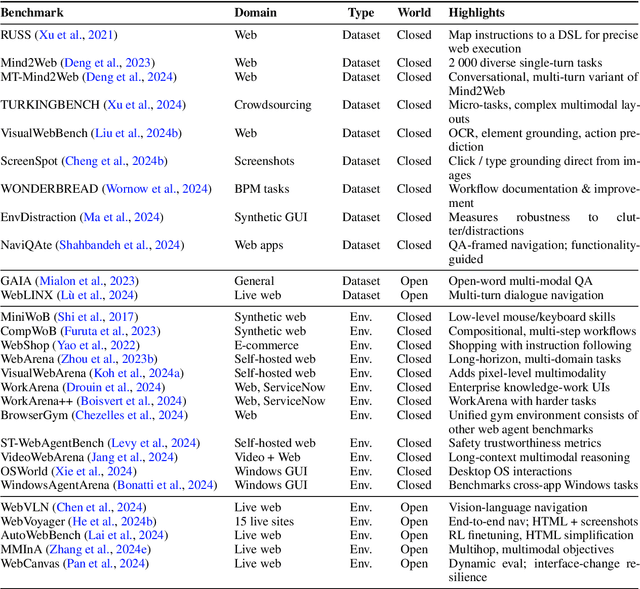
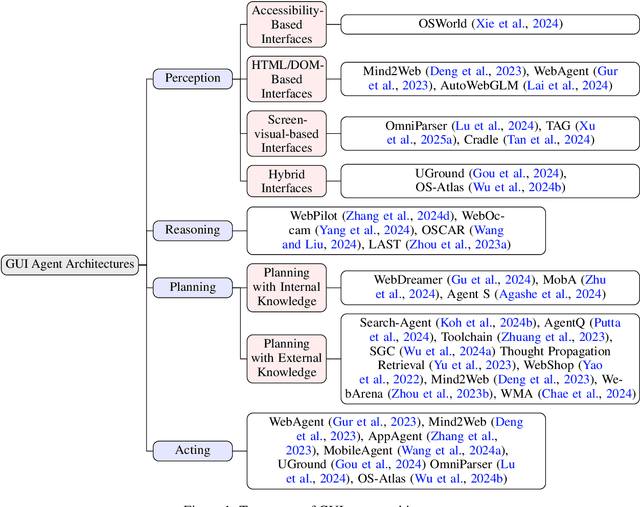

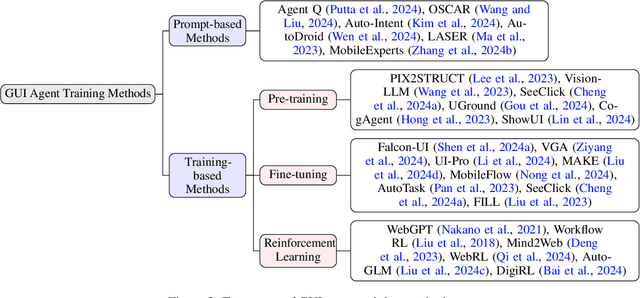
Abstract:Graphical User Interface (GUI) agents, powered by Large Foundation Models, have emerged as a transformative approach to automating human-computer interaction. These agents autonomously interact with digital systems or software applications via GUIs, emulating human actions such as clicking, typing, and navigating visual elements across diverse platforms. Motivated by the growing interest and fundamental importance of GUI agents, we provide a comprehensive survey that categorizes their benchmarks, evaluation metrics, architectures, and training methods. We propose a unified framework that delineates their perception, reasoning, planning, and acting capabilities. Furthermore, we identify important open challenges and discuss key future directions. Finally, this work serves as a basis for practitioners and researchers to gain an intuitive understanding of current progress, techniques, benchmarks, and critical open problems that remain to be addressed.
Personalized Multimodal Large Language Models: A Survey
Dec 03, 2024Abstract:Multimodal Large Language Models (MLLMs) have become increasingly important due to their state-of-the-art performance and ability to integrate multiple data modalities, such as text, images, and audio, to perform complex tasks with high accuracy. This paper presents a comprehensive survey on personalized multimodal large language models, focusing on their architecture, training methods, and applications. We propose an intuitive taxonomy for categorizing the techniques used to personalize MLLMs to individual users, and discuss the techniques accordingly. Furthermore, we discuss how such techniques can be combined or adapted when appropriate, highlighting their advantages and underlying rationale. We also provide a succinct summary of personalization tasks investigated in existing research, along with the evaluation metrics commonly used. Additionally, we summarize the datasets that are useful for benchmarking personalized MLLMs. Finally, we outline critical open challenges. This survey aims to serve as a valuable resource for researchers and practitioners seeking to understand and advance the development of personalized multimodal large language models.
GRS-QA -- Graph Reasoning-Structured Question Answering Dataset
Nov 01, 2024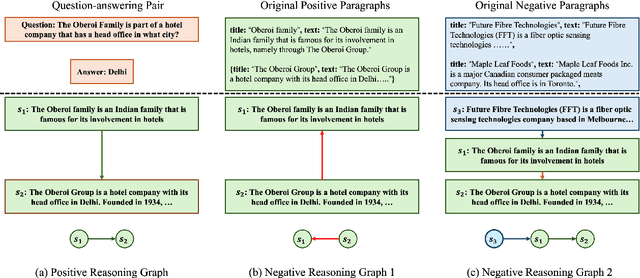
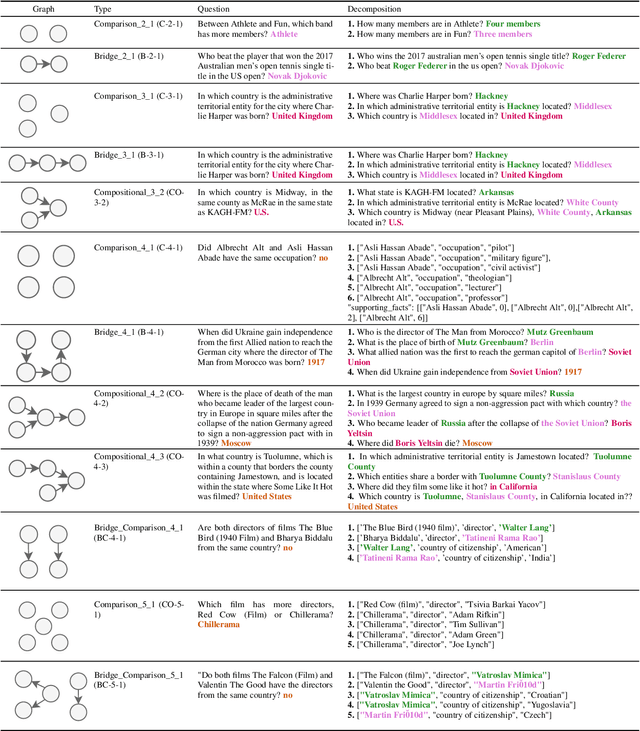


Abstract:Large Language Models (LLMs) have excelled in multi-hop question-answering (M-QA) due to their advanced reasoning abilities. However, the impact of the inherent reasoning structures on LLM M-QA performance remains unclear, largely due to the absence of QA datasets that provide fine-grained reasoning structures. To address this gap, we introduce the Graph Reasoning-Structured Question Answering Dataset (GRS-QA), which includes both semantic contexts and reasoning structures for QA pairs. Unlike existing M-QA datasets, where different reasoning structures are entangled together, GRS-QA explicitly captures intricate reasoning pathways by constructing reasoning graphs, where nodes represent textual contexts and edges denote logical flows. These reasoning graphs of different structures enable a fine-grained evaluation of LLM reasoning capabilities across various reasoning structures. Our empirical analysis reveals that LLMs perform differently when handling questions with varying reasoning structures. This finding facilitates the exploration of textual structures as compared with semantics.
A Survey of Small Language Models
Oct 25, 2024


Abstract:Small Language Models (SLMs) have become increasingly important due to their efficiency and performance to perform various language tasks with minimal computational resources, making them ideal for various settings including on-device, mobile, edge devices, among many others. In this article, we present a comprehensive survey on SLMs, focusing on their architectures, training techniques, and model compression techniques. We propose a novel taxonomy for categorizing the methods used to optimize SLMs, including model compression, pruning, and quantization techniques. We summarize the benchmark datasets that are useful for benchmarking SLMs along with the evaluation metrics commonly used. Additionally, we highlight key open challenges that remain to be addressed. Our survey aims to serve as a valuable resource for researchers and practitioners interested in developing and deploying small yet efficient language models.
Large Generative Graph Models
Jun 07, 2024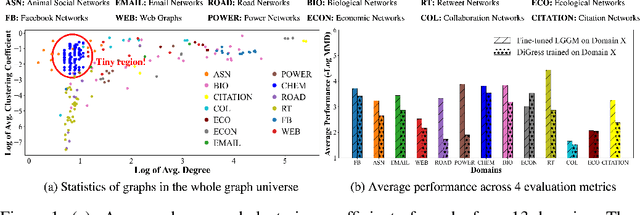
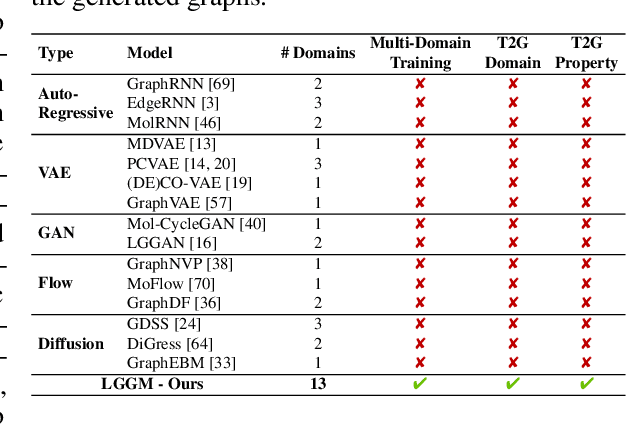
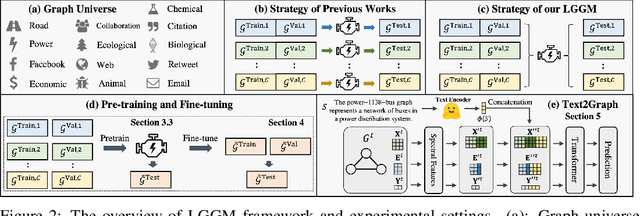
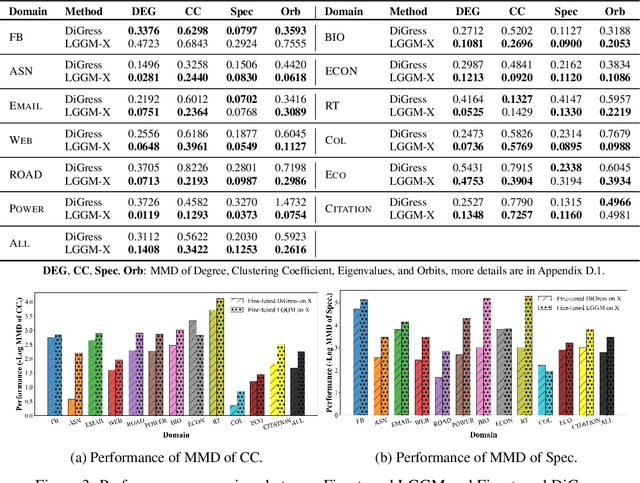
Abstract:Large Generative Models (LGMs) such as GPT, Stable Diffusion, Sora, and Suno are trained on a huge amount of language corpus, images, videos, and audio that are extremely diverse from numerous domains. This training paradigm over diverse well-curated data lies at the heart of generating creative and sensible content. However, all previous graph generative models (e.g., GraphRNN, MDVAE, MoFlow, GDSS, and DiGress) have been trained only on one dataset each time, which cannot replicate the revolutionary success achieved by LGMs in other fields. To remedy this crucial gap, we propose a new class of graph generative model called Large Graph Generative Model (LGGM) that is trained on a large corpus of graphs (over 5000 graphs) from 13 different domains. We empirically demonstrate that the pre-trained LGGM has superior zero-shot generative capability to existing graph generative models. Furthermore, our pre-trained LGGM can be easily fine-tuned with graphs from target domains and demonstrate even better performance than those directly trained from scratch, behaving as a solid starting point for real-world customization. Inspired by Stable Diffusion, we further equip LGGM with the capability to generate graphs given text prompts (Text-to-Graph), such as the description of the network name and domain (i.e., "The power-1138-bus graph represents a network of buses in a power distribution system."), and network statistics (i.e., "The graph has a low average degree, suitable for modeling social media interactions."). This Text-to-Graph capability integrates the extensive world knowledge in the underlying language model, offering users fine-grained control of the generated graphs. We release the code, the model checkpoint, and the datasets at https://lggm-lg.github.io/.
 Add to Chrome
Add to Chrome Add to Firefox
Add to Firefox Add to Edge
Add to Edge